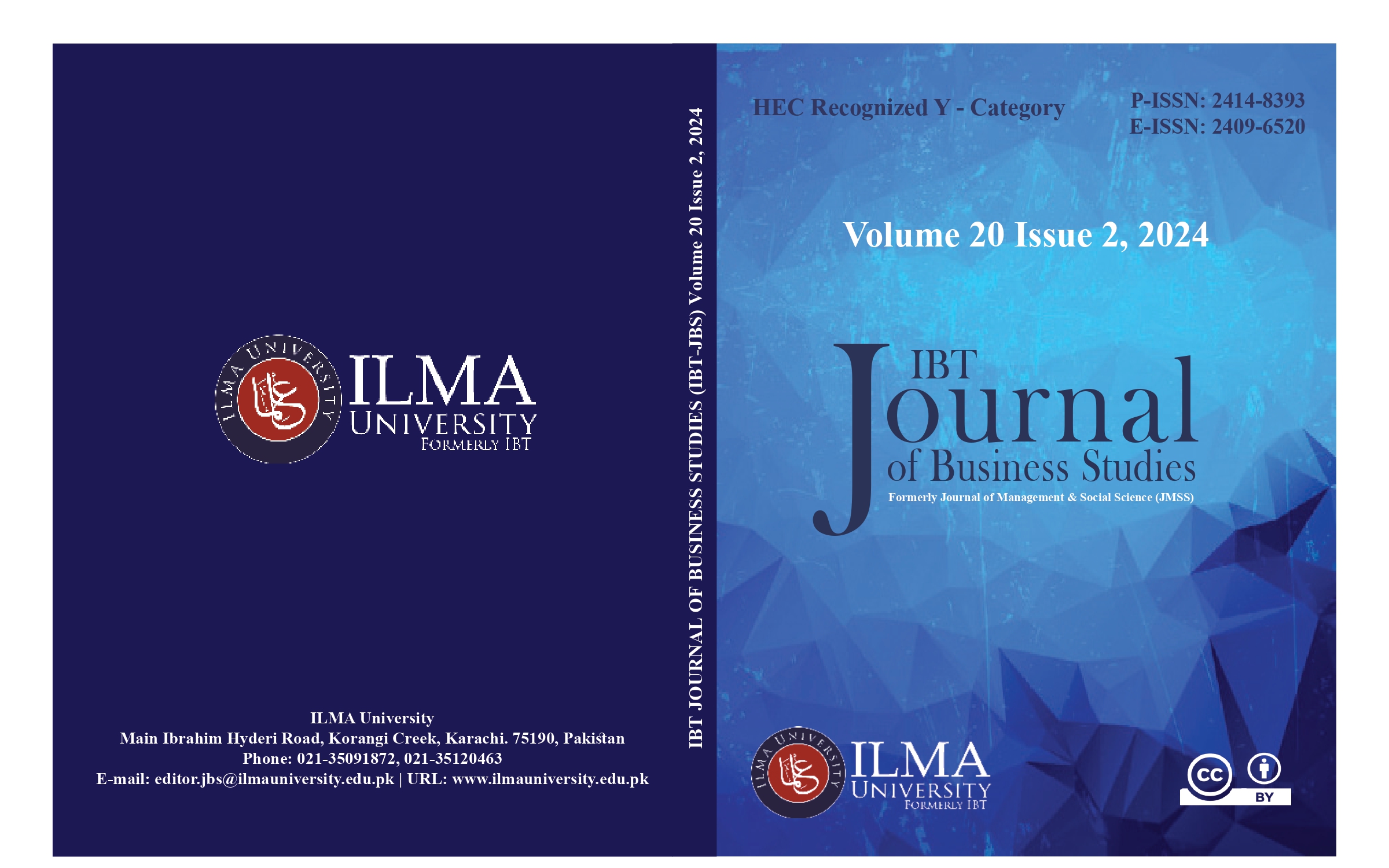Impact of Fintech & Monetary Policy on Liquidity Creation
DOI:
https://doi.org/10.46745/ilma.jbs.2024.20.02.01Keywords:
Fin-Tech, Liquidity Creation, Sustainable Liquidity Creation, Monetary PolicyAbstract
The study aims to identify the impact of monetary policy and financial technology on bank liquidity creation for commercial banks in Pakistan. The annual time series data was gathered from 2004-2003. The multiple regression technique was used to test the hypotheses. The findings suggest that FinTech and monetary policy significantly positively affect bank liquidity creation in Pakistan. It means that banks' adoption and implementation of FinTech enhance their ability to create economic liquidity. The State Bank of Pakistan must effectively use the monetary policy rate to control the liquidity the banks create in the economy, as the excess amount of liquidity creation harms the economy. However, the State Bank of Pakistan should effectively use the monetary policy rate to manage the liquidity creation. Future researchers should consider other factors, such as adopting artificial intelligence and sustainable development on liquidity creation in Pakistan or other countries. Sustainable liquidity creation must be introduced so that the economy's liquidity creation is environmentally friendly. Liquidity is created when banks finance illiquid assets by utilizing liquid liabilities; the banks must finance only those illiquid loans that are environmentally friendly.
References
Ali, A., & Ahmad, U. (2022). Liquidity Creation by Conventional Banks In Pakistan. Global Management Journal for Academic & Corporate Studies, 12(2), 69-82.
Ali, A., & Ahmad, U. (2023). Liquidity Creation and its Impact on Economic Growth: Moderating Role of Firm Size. Audit and Accounting Review, 3(2), 46-68.
Ali, A., Mughal, R., Minhas, A. A., & Abbas, Q. (2023). Nexus Between Monetary Policy & Liquidity Creation; Study From The Perspective Of Pakistan. International Journal of Finance Research, 4(1), 62-76.
Ali, S., Shah, S. Z. A., & Chughtai, S. (2019). The Role of Competition in influencing Bank Liquidity Creation: Evidence from China. Journal of Business & Economics, 11(1), 21-34.
Ansari, M., Almunawar, M. N., & Masri, M. (2020). Financial technology and disruptive innovation in business: Concept and application. International Journal of Asian Business and Information Management (IJABIM), 11(4), 29-43.
Ashcraft, A. B. (2006). New evidence on the lending channel. Journal of Money, Credit and Banking, 751-775.
Berger, A. N., & Bouwman, C. H. (2017). Bank liquidity creation, monetary policy, and financial crises. Journal of Financial Stability, 30, 139-155.
Berger, A. N., Guedhami, O., Kim, H. H., & Li, X. (2020). Economic policy uncertainty and bank liquidity hoarding. Journal of Financial Intermediation, 100893.
Berger, A. N., Imbierowicz, B., & Rauch, C. (2016). The roles of corporate governance in bank failures during the recent financial crisis. Journal of Money, Credit and Banking, 48(4), 729-770.
Berger, A. N., & Udell, G. (1995). Relationship lending and lines of credit in small firm finance. Journal of Business, 27, 351–382.
Berger, A. N., & Bouwman, C. H. (2009). Bank liquidity creation. Review of Financial Studies, 22, 3779-3837.
Boerman, S. C., & Van Reijmersdal, E. A. (2020). Disclosing influencer marketing on YouTube to children: The moderating role of para-social relationship. Frontiers in Psychology, 10, 3042.
Daga, R., Nawir, F., & Pratiwi, D. (2021). Strategies to Improve Service Quality Through Digitalization of Banking Services at PT. Bank Negara Indonesia (Persero) Tbk. Quantitative Economics and Management Studies, 2(5), 318-325.
Diamond, D. W., & Dybvig P. H. (1983). Bank runs, deposit insurance, and liquidity. Journal of Political Economy, 91, 401-19.
Diamond, D. W. (1984). Financial intermediation and delegated monitoring. The Review of Economic Studies, 51(3), 393-414.
Diamond, D. W., & Rajan, R. G. (2001). Liquidity risk, liquidity creation, and financial fragility: A theory of banking. Journal of Political Economy, 109(2), 287-327.
Fang, Y., Wang, Q., Wang, F., & Zhao, Y. (2023). Bank fintech, liquidity creation, and risk- taking: Evidence from China. Economic Modelling, 127, 106445.
Guo, P., & Zhang, C. (2023). The impact of bank FinTech on liquidity creation: Evidence from China. Research in International Business and Finance, 64, 101858.
Hussain, M., & Bashir, U. (2019). Impact of monetary policy on bank lending: Does market structure matter?. International Economic Journal, 33(4), 620-648.
Kishan, R. P., & Opiela, T. P. (2000). Bank size, bank capital, and the bank lending channel. Journal of Money, credit and banking, 121-141.
Liu, S., Wang, B., & Zhang, Q. (2024). Fintech regulation and bank liquidity creation: Evidence from China. Pacific-Basin Finance Journal, 84, 102276.
Okoli, T. T., & Tewari, D. D. (2020). An empirical assessment of fintechs heterogeneous transmission channels to financial development among African economies. Cogent Economics & Finance, 8(1), 1829273.
Suryono, R. R., Budi, I., & Purwandari, B. (2020). Challenges and trends of financial technology (Fintech): a systematic literature review. Information, 11(12), 590.
Wu, Z., Pathan, S., & Zheng, C. (2024). FinTech adoption in banks and their liquidity creation. The British Accounting Review, 101322.
Downloads
Published
How to Cite
Issue
Section
License
Copyright (c) 2025 - Author(s) retain(s) full copyright of this paper

This work is licensed under a Creative Commons Attribution 4.0 International License.
All articles are published under Creative Commons License term i.e. CC BY 4.0 International




